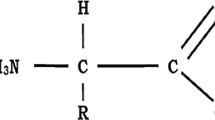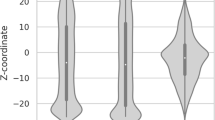Abstract
Back-propagation, feed-forward neural networks are used to predict the secondary structures of membrane proteins whose structures are known to atomic resolution. These networks are trained on globular proteins and can predict globular protein structures having no homology to those of the training set with correlation coefficients (C) of 0.45, 0.32 and 0.43 for αa-helix, β-strand and random coil structures, respectively. When tested on membrane proteins, neural networks trained on globular proteins do, on average, correctly predict (Qi) 62%, 38% and 69% of the residues in the α-helix, β-strand and random coil structures. These scores rank higher than those obtained with the currently used statistical methods and are comparable to those obtained with the joint approaches tested so far on membrane proteins. The lower success score for β-strand as compared to the other structures suggests that the sample of β-strand patterns contained in the training set is less representative than those of a-helix and random coil. Our analysis, which includes the effects of the network parameters and of the structural composition of the training set on the prediction, shows that regular patterns of secondary structures can be successfully extrapolated from globular to membrane proteins.
Similar content being viewed by others
References
Allewell N (1991) Long-range interactions in proteins. TIBS 16:239–240
Anfinsen CB (1973) Principles that govern the folding of protein chains. Science 181:223–230
Bernstein FC, Koetzle TF, Williams GJB, Meyer EF, Brice MD, Rodgers JR, Kennard O, Shimanouchi T, Tasumi M (1977) The protein data bank: a computer-based archival file for macromolecular structures. J Mol Biol 112:535–542
Blundell TL, Sibanda BL, Sternberg MJE, Thornton JM (1987) Knowledge-based prediction of protein structures and the design of novel molecules. Nature 326:347–352
Bohr H, Bohr J, Brunak S, Cotterill RMJ, Lautrup B, Norskov L, Olsen OH, Petersen SB (1988) Protein secondary structure and homology by neural networks. The α-helices in rhodopsin. FEBS Lett 241:223–228
Bowie JU, Lüthy R, Eisenberg D (1991) A method to identify protein sequences that fold into a known three-dimensional structure. Science 235:164–170
Burgess AW, Ponnuswamy PK, Scheraga HA (1974) Analysis of conformations of amino acid residues and prediction of backbone topography in proteins. Isr J Chem 12:239–286
Chothia C (1992) One thousand families for the molecular biologist. Nature 357:543–544
Chou PY, Fasman GD (1974) Prediction of protein conformation. Biochemistry 13:222–244
Compiani M, Fariselli P, Casadio R (1991) Neural networks extracting general features of protein secondary structures. In: Caianiello ER (ed) Parallel architectures and neural networks. World Scientific, Singapore, pp 227–237
Compiani M, Fariselli P, Casadio R (1992) The statistical behaviour of perceptrons. In: Caianiello ER (ed) Parallel architectures and neural networks. World Scientific, Singapore, pp 111–117
Deisenhofer J, Epp O, Miki K, Huber R, Michel H (1985) Structure of the protein subunits in the photosynthetic reaction centre of Rhodopseudomonas viridis at 3 Å resolution. Nature 318:618–624
Fasman GD (1989) The development of the prediction of protein structure. In: Fasman GD (ed) Prediction of protein structure and the principles of protein conformation. Plenum Press, New York, pp 193–316
Fasman GD, Gilbert WA (1990) The prediction of transmembrane protein sequences and their conformation: an evaluation. TIBS 15:89–92
Feher G, Allen JP, Okamura MY, Rees DC (1989) Structure and function of bacterial photosynthetic reaction centres. Nature 339:111–116
Friedrichs MS, Wolynes PG (1989) Towards protein tertiary structure recognition by means of associative memory hamiltonians. Science 246:371–373
Garnier J, Levin JM (1991) The protein code: what is the present status? CABIOS 7:133–142
Garnier J, Robson B (1989) The GOR method for predicting secondary structures in proteins. In: Fasman GD (ed) Prediction of protein structure and the principles of protein conformation. Plenum Press, New York, pp 417–465
Garnier J, Levin JM, Gibrat JF, Biou V (1990) Secondary structure prediction and protein design. Biochem Soc Symp 57:11–24
Garratt RC, Taylor WR, Thornton JM (1985) The influence of tertiary structure on secondary structure prediction. Accessibility versus predictability for β-structure. FEBS Lett 188:59–62
Gibrat JF, Garnier J, Robson B (1987) Further developments of protein secondary structure prediction using information theory. J Mol Biol 198:425–443
Gibrat JF, Robson B, Garnier J (1991) Influence of the local amino acid sequence upon the zones of the torsional angles 0 and tar adopted by residues in proteins. Biochemistry 30:1578–1586
Henderson R, Baldwin JM, Ceska TA, Zemlin F, Beckmann E, Downing KH (1990) Model for the structure of bacteriorhodopsin based on high-resolution electron cryo-microscopy. J Mol Biol 213:899–929
Hinds DA, Levitt M (1992) A lattice model for protein structure prediction at low resolution. Proc Natl Acad Sci USA 89:2536–2540
Hirst JD, Sternberg JE (1992) Prediction of structural and functional features of protein and nucleic acid sequences by artificial neural network. Biochemistry 31:7211–7218
Holley HL, Karplus M (1989) Protein secondary structure prediction with a neural network. Proc Natl Acad Sci USA 86:152–156
Jähnig F (1989) Structure prediction for membrane proteins. In: Fasman GD (ed) Prediction of protein structure and the principle of protein conformation. Plenum Press, New York, pp 707–717
Jennings ML (1989) Topography of membrane proteins. Annu Rev Biochem 58:999–1027
Kabsch W, Sander C (1983a) Dictionary of protein secondary structure: pattern of hydrogen-bonded and geometrical features. Biopolymers 22:2577–2637
Kabsch W, Sander C (1983b) How good are predictions of protein secondary structure? FEBS Lett 155:179–182
Kabsch W, Sander C (1984) On the use of sequence homologies to predict protein structure: identical pentapeptides can have completely different conformation. Proc Natl Acad Sci USA 81:1075–1078
Karplus M, Petsko GA (1990) Molecular dynamics simulations in biology. Nature 347:631–639
Kneller DG, Cohen FE, Langridge R (1990) Improvements in protein secondary structure prediction by an enhanced neural network. J Mol Biol 214:171–182
Li Z, Scheraga HA (1987) Monte Carlo-minimization approach to the multiple-minima problem in protein folding. Proc Natl Acad Sci USA 84:6611–6615
Lipman DJ, Pearson WR (1985) Rapid and sensitive similarity searches. Science 227:1435–1441
Matthews BW (1975) Comparison of the predicted and observed secondary structure of T4 phage lysozyme. Biochim Biophys Acta 405:442–451
McGregor M, Flores TP, Sternberg MJE (1989) Prediction of β-turns in proteins using neural networks. Protein Eng 2:521–526
Müller D, Reinhardt J (1990) Neural networks. Springer, Berlin Heidelberg New York
Muskal SM, Kim SH (1992) Predicting protein secondary structure content. A tandem neural network approach. J Mol Biol 225:713–727
Pascarella S, Bossa F (1989) PRONET: a microcomputer program for predicting the secondary structure of proteins with a neural network. CABIOS 5:319–320
Qian N, Sejnowski TG (1988) Predicting the secondary structure of globular proteins using neural network models. J Mol Biol 202:865–884
Rapaport TA (1991) A bacterium catches up. Nature 369:107–108
Rumelhart DE, Hinton GE, Williams RJ (1986) Learning representation by back-propagating errors. Nature 323:533–536
Schiltz E, Kreusch A, Nestel U, Schultz E (1991) Primary structure of porin from Rhodobacter capsulatus. Eur J Biochem 199:587–594
Schulz GE (1988) A critical evaluation of methods for prediction of protein secondary structures. Ann Rev Biophys Chem 17:1–21
Schulz GE, Schirmer RH (1979) Principles of protein structure. Springer, Berlin Heidelberg New York
Stolorz P, Lapedes A, Xia Y (1992) Predicting protein secondary structure using neural net and statistical methods. J Mol Biol 225:363–377
Terwilliger TC, Weissman L, Eisenberg D (1982) The structure of melittin in the form I crystals and its implication for melittin's lytic and surface activities. Biophys J 27:353–361
Viswanadhan VN, Denckla B, Weinstein JN (1991) New joint prediction algorithm (Q,7-JASEP) improves the prediction of protein secondary structure. Biochemistry 30:11164–11172
Von Heijne G (1988) Transcending the impenetrable: how proteins come to terms with membranes. Biochim Biophys Acta 947:307–333
Wallace BA, Cascio M, Mielke DL (1986) Evaluation of methods for the prediction of membrane protein secondary structures. Proc Natl Acad Sci USA 83:9423–9427
Weiss MS, Kreusch A, Schiltz E, Nestel U, Welte W, Weckesser J, Schulz GE (1991) The structure of porin from Rhodobacter capsulatus at 1.8 Å resolution. FEBS Lett 280:379–382
Author information
Authors and Affiliations
Additional information
Correspondence to: R. Casadio
Rights and permissions
About this article
Cite this article
Fariselli, P., Compiani, M. & Casadio, R. Predicting secondary structures of membrane proteins with neural networks. Eur Biophys J 22, 41–51 (1993). https://doi.org/10.1007/BF00205811
Received:
Accepted:
Issue Date:
DOI: https://doi.org/10.1007/BF00205811




